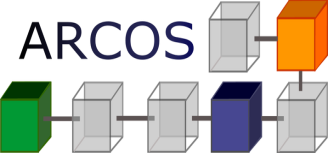Our activities
ARCOS GROUP OF COMPUTER SCIENCE DEPARTMENT

The following list showcases the related ST3LLAR activities of the Computer Science group.
ACTIVITIES
This section exhibits the research performed by the ARCOS team in the ST3LLAR framework.
The covered areas are new paradigms of operating systems suitable for space usage, software modelling, high abstraction layers and software services.
1 – Definition and modelling of an Onboard Software architecture for nanosatellites development
In this end-of-degree project, the architecture of the onboard software and simulated hardware of a nanosatellite is defined, as well as the ground station that controls it. It is the result of the collaboration between the University Carlos III of Madrid and the company SENER in the UC3M-SENER Aerospace Chair, whose objective is to develop a nanosatellite with students from different engineering degrees from the University Carlos III of Madrid. This project is part of the Computer Science and Engineering group.
Professional tools have been used to define the nanosatellite’s mission in requirements documents and the later system modelling using the system modelling language SysML.
Moreover, the system integration, verification and acceptance tests of the system have been defined.



2 – Definition and implementation of a Hardware-Software embedded platform for nanosatellites development
This project is responsible for the definition of the software development environment and the integration of the onboard computer software into an embedded system.
The development of the embedded system is fundamental, as it will be in charge of executing the onboard software. For this project, the embedded system is based on an ARM BeagleBoard-XM. The onboard software is executed on a Real Time Operating System.
In regards to system verification, we perform software-in-the-loop validation (which tests the system on a hardware emulator), and hardware-in-the-loop validation (which tests the system on the real hardware).

3 – Development of a satellite Ground System
This project aims to show clearly how is the process of developing a satellite ground
system. The Ground System must be able to communicate with the satellite in order to manage the various situations it faces in outer space in order
to avoid material losses. In addition the Ground System produces an action on the satellite sending commands and receives the information of the situation in which the satellite is using telemetry packages.
The action commands and telemetry packages are defined in an external database
called MIB Tool with which the satellite must interact.


4 – Development of a Failure Detection and Isolation Recovery
This work is linked to the design and develop the satellite software. Specifically, this bachelor degree will be responsible for the satellite software error detection and recovery module. This document explains in detail the process followed to design and implement this module.


5 – Comms software modules implementation for satellites development
Communications Software Module allows the ground software to communicate with the rest of the system modules. This work details the design and implementation process of the Communications Module, as well as its structure and function within the onboard software.



6 – Design and development of a task scheduler for satellites development
This work is based on the development of the Real-Time task planning, the so called “scheduler”. The scheduler is the responsible of transfer the available execution time slices to a task code, or to set a task as active in case of use a Real-Time kernel.
This Scheduler needs to be implemented with the restrictions imposed by Core Flight System, a software layer used previously on past work, which information is also available on this page.


7 – Design an implementation of software modules; thermal sensor and telemetries
Monitoring the system is fundamental for the success of the mission, because errors can be corrected from the ground segment. Therefore, the objective of this project is the design and implementation of the telemetry module, as well as a software simulation of the thermal components of the system. These modules have been made with the cFE framework of NASA, which facilitates the development using its services.


8 – Design and implementation of a Mission Data management tool for satellites development
This work provides an information database related to the development and operation of a nanosatellite. From the modules neccesary to establish the organisation of the tasks that it has to do to complete its job successfully, to the build of the communication with the Earth’s base to be able of exchange packages of information with it. Besides, it will contain the definition of the mission designed to define the mission that has to manage all the data packages transmitted between this nanosatellite and the earth’s segment which will manage all the operations that the satellite has to do on its life cycle. The management of these data packages is done through the creation of different telemetries associated to each sensor of the nanosatellite (solar panel, temperature, GPS…).


These telemetries will have to be configured to carry out the receiving of data through the earth’s segment, following the standard prepared for the type of information that we are going to obtain. In addition, we will establish the configuration of all the missions that we will send to the nanosatellite with the objective that it will be able to do a single action for each mission.